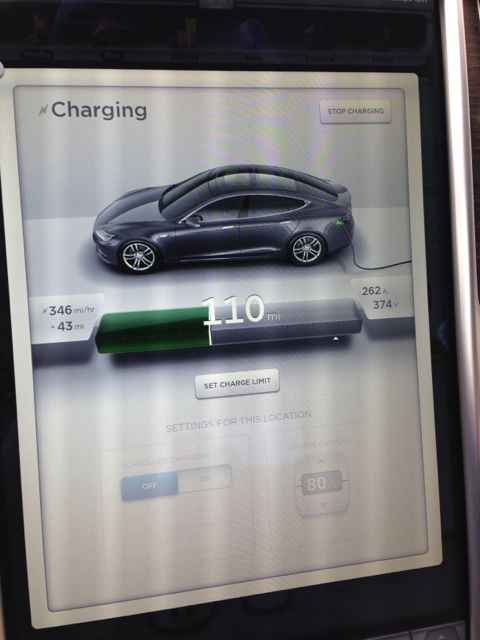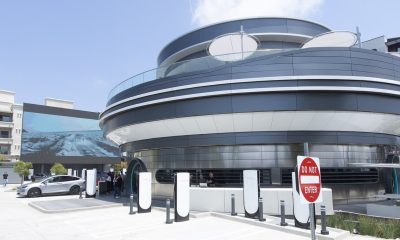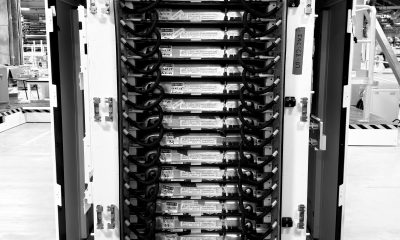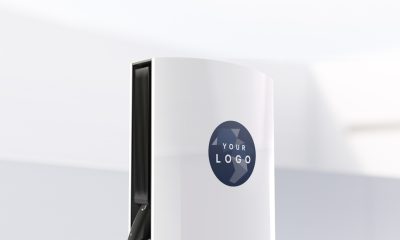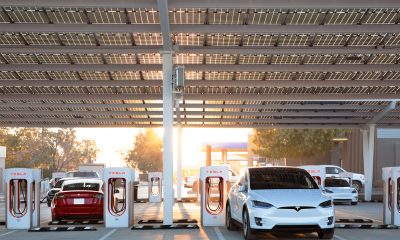Tesla Model S
How to use a Tesla Supercharger and what to expect
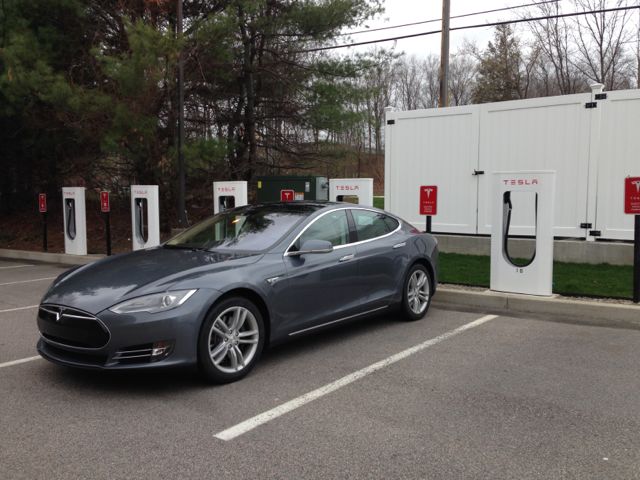
Today I had to drop off my mother-in-law at Providence airport and I used it as an excuse to make my first Tesla Supercharger visit at the East Greenwich, RI Supercharger. This is currently the northern-most Supercharger on the east coast in the US and located 10 minutes south of Providence Airport (PVD).
I decided not to charge up the night before and left my Model S with 127 miles of range on it. With that amount of range I would have enough to get to the airport, drive to the Supercharger and still drive home if for some reason the Supercharger didn’t work.
Connecting to the Tesla Supercharger
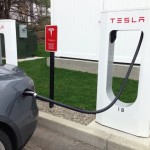 Superchargers appear to have different layouts depending on the location, some you back into while others require you to pull forward – this one is the former. You’ll want to be pretty close to the Supercharger since the cable is relatively short. The charger will always need to be to the left side of the car since that’s where the charge port door is. The rear view camera helps a ton and combined with the parking sensors really allow you to get close without being too close. I love how the parking sensor displays your proximity measurements (in inches for the US).
Superchargers appear to have different layouts depending on the location, some you back into while others require you to pull forward – this one is the former. You’ll want to be pretty close to the Supercharger since the cable is relatively short. The charger will always need to be to the left side of the car since that’s where the charge port door is. The rear view camera helps a ton and combined with the parking sensors really allow you to get close without being too close. I love how the parking sensor displays your proximity measurements (in inches for the US).
Once parked and situated you’ll want to pop open the charge port and insert the thick Supercharger cable. I had some difficulties with this at first and encountered a red ring indicating that there was a bad connection.
I pushed the handle in with a bit more force and noticed the red indicator light started to pulsate in green. The center touchscreen read “Preparing for charge” and so I waited. To my surprise the next message popped up and said “unable to charge” so I got out of the car, unplugged the cable and firmly reseated it once more. I waited through the same preparation phase until the car finally began to start charging.
I’ve heard from other owners that Tesla Supercharger connections can be a bit finicky at times so if you don’t succeed at first, try again before moving onto another charging bay.
Supercharger Charging Sequence
Once you’ve successfully made it past the charge preparation sequence, the car will indicate that it’s starting to charge and display the voltage and amperage in which you’re charging at. It takes a few seconds before it ramps up to its peak charge rate which for me read 346 miles/hour at 262A/374V. The peak rate of charge will vary depending on whether its the older 90kW or newer 120kW Superchargers.
Supercharging
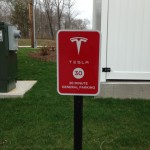 I explored the shopping center where the Supercharger station was located. In fact the Supercharger bays at this location was simply eight additional parking spots slotted next to a Walgreens. There’s also an Outback, Ruby Tuesdays, Panera and McDonalds in the area all within walking distance. I decided to go into Panera for a warm drink. It was 40 degrees and approaching May – welcome to New England.
I explored the shopping center where the Supercharger station was located. In fact the Supercharger bays at this location was simply eight additional parking spots slotted next to a Walgreens. There’s also an Outback, Ruby Tuesdays, Panera and McDonalds in the area all within walking distance. I decided to go into Panera for a warm drink. It was 40 degrees and approaching May – welcome to New England.
Another thing I noticed at the location is that 5 slots are marked for “Tesla Electric Vehicle” whereas the other 3 are marked for general parking 30 minutes. While I was sitting there waiting for my charge, a Walgreens customer took advantage of the 30 minute parking rule for a brief moment, but otherwise the slots were all open for Tesla owners. New England still ranks pretty low in terms of Tesla ownership per capita.
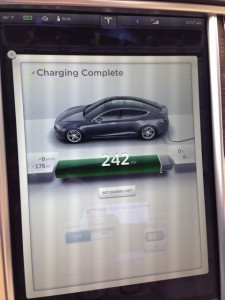 My charge finished at exactly 50 minutes taking me from 67 miles of rated range to 242 miles of rated range at a 90% state of charge. This equated to 175 miles of charge in 50 minutes. My understanding of the rate of charge can go even higher when you start your charge from near-zero but i’d have a serious case of range anxiety if I did that.
My charge finished at exactly 50 minutes taking me from 67 miles of rated range to 242 miles of rated range at a 90% state of charge. This equated to 175 miles of charge in 50 minutes. My understanding of the rate of charge can go even higher when you start your charge from near-zero but i’d have a serious case of range anxiety if I did that.
All the displays on the car through the process were great. The one thing I wish they did was give you an estimated time to charge complete. The calculation isn’t simple since they’re varying charge over time, it depends on the state of the Supercharger, if the bay next to you is empty, etc. If it would pop up and say “You’ve got about 45 minutes to do something else” it would have been more helpful. I’m sure some smart people at Tesla can figure out how to do that.
In the end, I got 175 miles of range for free and the experience was great. Now all I need is an excuse to take an extended Supercharger road trip!
Lifestyle
Tesla Model S Plaid battles China’s 1500 hp monster Nurburgring monster, with surprising results
There is just something about Tesla’s tuning and refinement that makes raw specs seem not as game-changing.

The Tesla Model S Plaid has been around for some time. Today, it is no longer the world’s quickest four-door electric sedan, nor is it the most powerful. As per a recent video from motoring YouTube channel Carwow, however, it seems like the Model S Plaid is still more than a match for some of its newer and more powerful rivals.
The monster from China
The Xiaomi SU7 Ultra is nothing short of a monster. Just like the Model S Plaid, it features three motors. It also has 1,548 hp and 1,770 Nm of torque. It’s All Wheel Drive and weighs a hefty 2,360 kg. The vehicle, which costs just about the equivalent of £55,000, has been recorded setting an insane 7:04.957 at the Nurburgring, surpassing the previous record held by the Porsche Taycan Turbo GT.
For all intents and purposes, the Model S Plaid looked outgunned in Carwow’s test. The Model S Plaid is no slouch with its three motors that produce 1,020 hp and 1,420 Nm of torque. It’s also a bit lighter at 2,190 kg despite its larger size. However, as the Carwow host pointed out, the Model S Plaid holds a 7:25.231 record in the Nurburgring. Compared to the Xiaomi SU7 Ultra’s record, the Model S Plaid’s lap time is notably slower.
Real-world tests
As could be seen in Carwow’s drag races, however, Tesla’s tech wizardry with the Model S Plaid is still hard to beat. The two vehicles competed in nine races, and the older Model S Plaid actually beat its newer, more powerful counterpart from China several times. At one point in the race, the Xiaomi SU7 Ultra hit its power limit due to its battery’s temperature, but the Model S Plaid was still going strong.
The Model S Plaid was first teased five years ago, in September 2020 during Tesla’s Battery Day. Since then, cars like the Lucid Air Sapphire and the Xiaomi SU7 Ultra have been released, surpassing its specs. But just like the Model Y ended up being the better all-rounder compared to the BYD Sealion 7 and the MG IM6, there is just something about Tesla’s tuning and refinement that makes raw specs seem not as game-changing.
Check out Carwow’s Model S Plaid vs Xiaomi SU7 drag race video below.
News
This signature Tesla feature is facing a ban in one of its biggest markets
The report indicates that Chinese government agencies have concerns “about failure rates and safety issues with the flush design.”
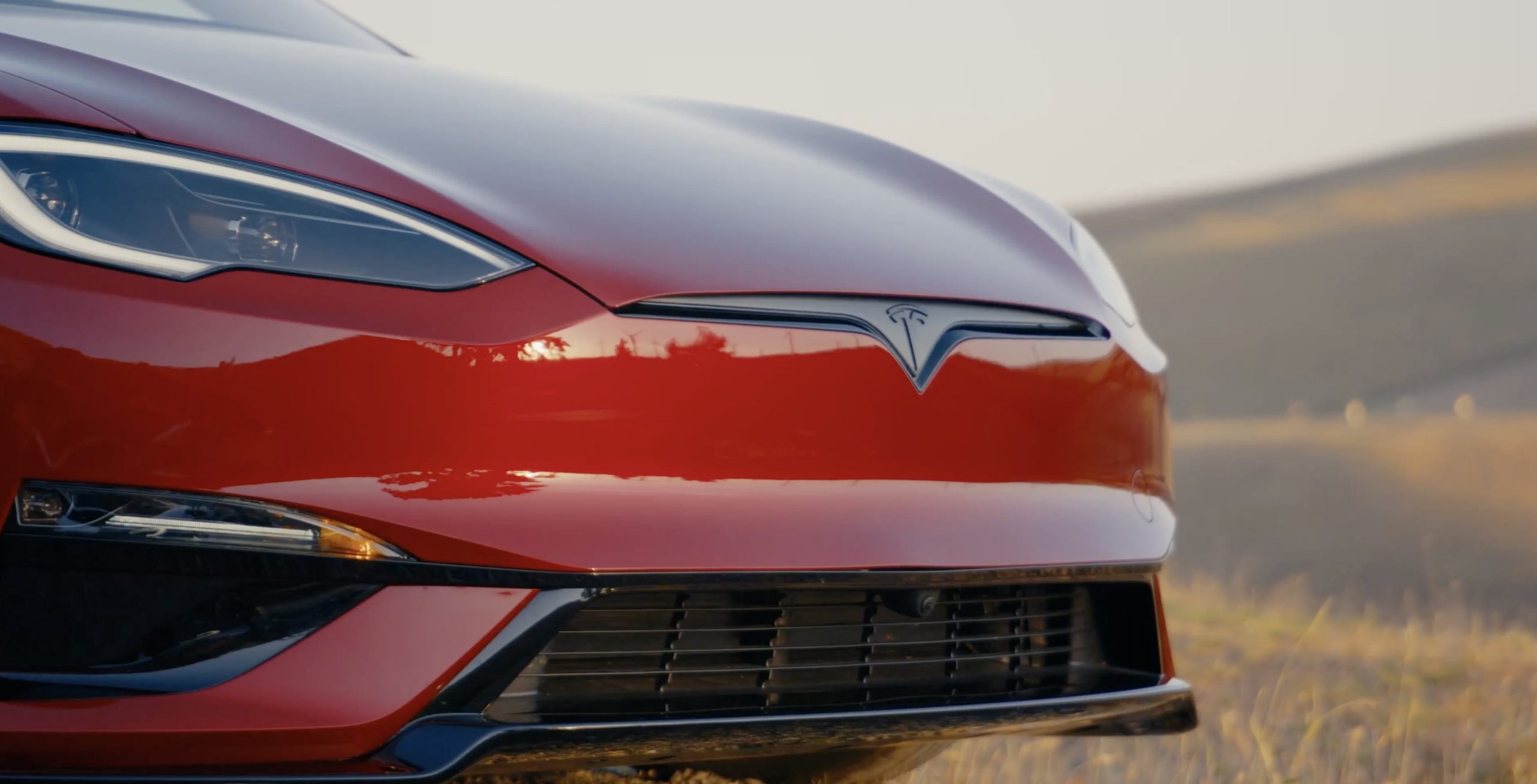
A signature Tesla feature is under fire in one of the company’s largest markets, as regulators in one EV hot spot are mulling the potential ban of a design the automaker implemented on some of its vehicles.
Tesla pioneered the pop-out door handle on its Model S back in 2012, and CEO Elon Musk felt the self-presenting design was a great way to feel like “you’re part of the future.”
It is something that is still present on current Model S designs, while other vehicles in the Tesla lineup have a variety of handle aesthetics.
According to Chinese media outlet Mingjing Pro, the company, along with others using similar technology, is facing scrutiny on the design as regulators consider a ban on the mechanism. These restrictions would impact other companies that have utilized pop-out handles on their own designs; Tesla would not be the only company forced to make changes.
The report indicates that Chinese government agencies have concerns “about failure rates and safety issues with the flush design.”
However, EVs are designed to be as aerodynamically efficient as possible, which is the main reason for this design. It is also the reason that many EVs utilize wheel covers, and sleek and flowing shapes.
However, the Chinese government is not convinced, as they stated the aerodynamic improvements are “minimal,” and safety issues are “significantly elevated,” according to The Independent.
The issue also seems to be focused on how effective the handle design is. According to data, one EV manufacturer, which was not specified in the report, has 12 percent of its total repairs are door handle failure fixes.
There are also concerns about the handles short-circuiting, leaving passengers trapped within cars. Tesla has implemented emergency latch releases in its vehicles that would prevent passengers from getting stuck in their cars in cases of electric malfunctions or failures.
However, evidence from the Chinese Insurance Automotive Technology Research Institute (C-IASI) suggests that 33 percent of door handles using this design fail to function after a side impact.
Obviously, Tesla and other automakers could introduce an alternative design to those vehicles that are affected by the potential restrictions China intends to impose. The regulation would take effect in July 2027.
News
Tesla pushes crazy ‘Luxe’ incentive package on flagship Model S and X
Tesla is pushing more customers to the Model S and Model X with a new incentive package.
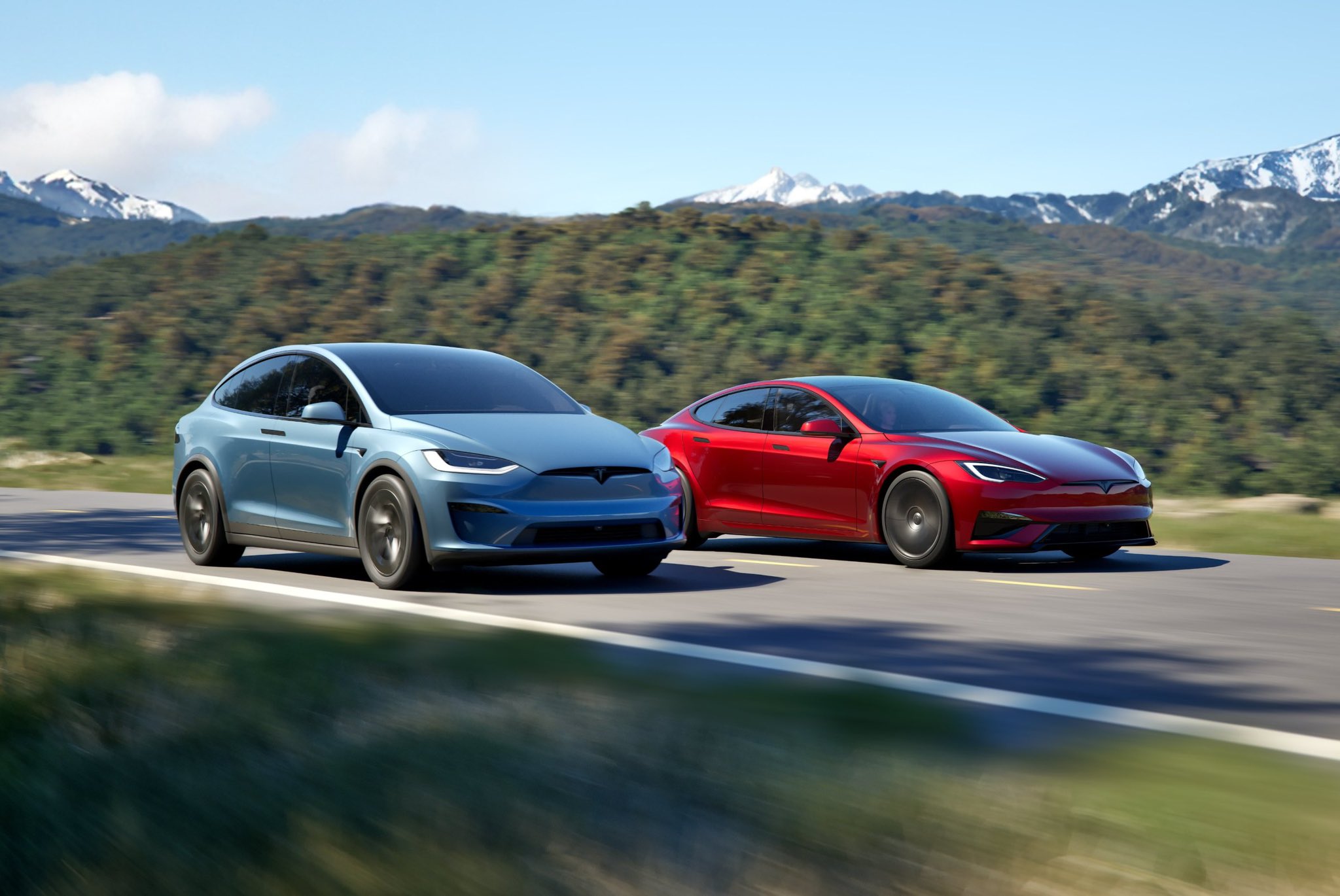
Tesla has pushed a crazy new incentive package, known as the “Luxe Package,” on the flagship Model S and Model X, along with a $10,000 price increase on each trim level.
The move aims to likely bolster margins for the company on the two cars while also giving those who choose to buy the Tesla lineup mainstays a variety of awesome advantages, including Free Supercharging, Full Self-Driving, and other add-ons.
Tesla is offering a crazy Supercharging incentive on its two ‘sentimental’ vehicles
Last night, Tesla launched the “Luxe Package” for the Model S and Model X, which includes the following four add-ons:
- Full Self-Driving (Supervised) – Your car will be able to drive itself almost anywhere with minimal driver intervention
- Four-Year Premium Service – Wheel and Tire Protection, Windshield Protection, and Recommended Maintenance
- Supercharging – Charge for free at 70,000+ Superchargers worldwide
- Premium Connectivity – Listen to music, stream movies, monitor live traffic, and more – no Wi-Fi needed
Full Self-Driving is priced at $8,000. Free Supercharging for the life of the car is between $10,000 and $15,000 over the life of the vehicle, although Tesla has valued it at $5,000 in recent promotions.
Free Premium Connectivity is roughly $1,000, and the four-year tire, wheel, windshield, and maintenance plan is about $3,200.
🚨 Tesla increased the price of both the Model S and Model X by $10,000, but both vehicles now include the “Luxe Package,” which includes:
-Full Self-Driving
-Four years of included maintenance, tire and wheel repairs, and windshield repairs/replacements
-Free lifetime… pic.twitter.com/LKv7rXruml— TESLARATI (@Teslarati) August 16, 2025
In all, the value is over $25,000, but this is loosely based on usage.
The Model S and Model X are low contributors to Tesla’s overall sales figures, as they make up less than five percent of sales from a quarterly perspective and have for some time.
As they are certainly the luxury choices in Tesla’s lineup, the Model 3 and Model Y are the bigger focus for the company, as a significantly larger portion of the company’s sales is made up of those vehicles.
The Luxe Package is an especially good idea for those who drive high-mileage and plan to use the Model S or Model X for commuting or long drives. The free Supercharging makes the deal worth it on its own.
As for the price bumps, each of the vehicles are now priced as follows:
- Model S All-Wheel-Drive: $94,990
- Model S Plaid: $109,990
- Model X All-Wheel-Drive: $99,990
- Model X Plaid: $114,990
-
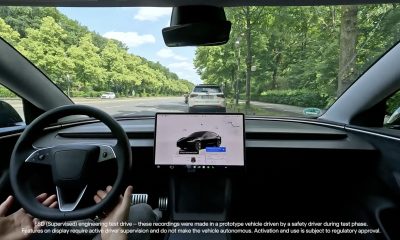
 Elon Musk2 weeks ago
Elon Musk2 weeks agoTesla FSD V14 set for early wide release next week: Elon Musk
-
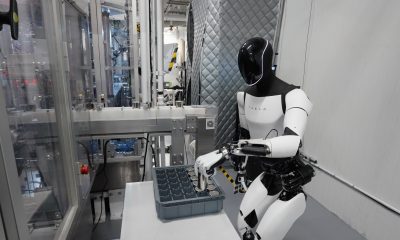
 News1 week ago
News1 week agoElon Musk gives update on Tesla Optimus progress
-
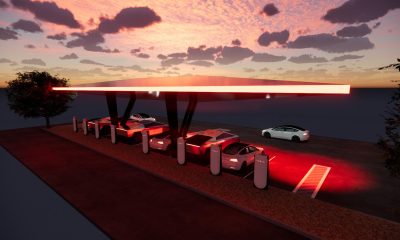
 News2 weeks ago
News2 weeks agoTesla has a new first with its Supercharger network
-
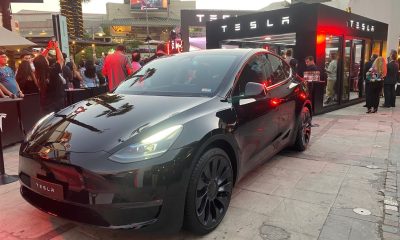
 News2 weeks ago
News2 weeks agoTesla job postings seem to show next surprise market entry
-
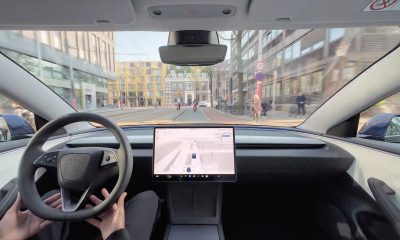
 Investor's Corner2 weeks ago
Investor's Corner2 weeks agoTesla gets new Street-high price target with high hopes for autonomy domination
-
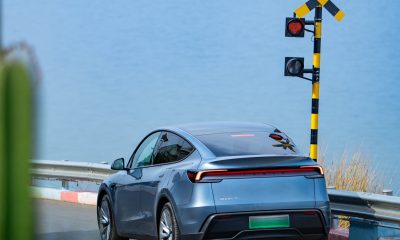
 Lifestyle1 week ago
Lifestyle1 week ago500-mile test proves why Tesla Model Y still humiliates rivals in Europe
-
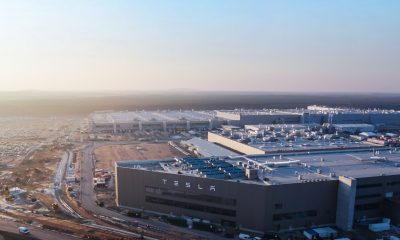
 News1 week ago
News1 week agoTesla Giga Berlin’s water consumption has achieved the unthinkable
-
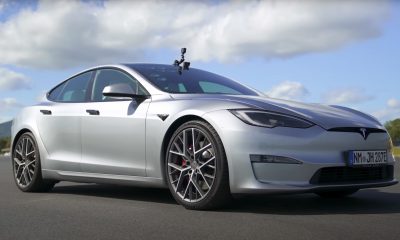
 Lifestyle1 week ago
Lifestyle1 week agoTesla Model S Plaid battles China’s 1500 hp monster Nurburgring monster, with surprising results


